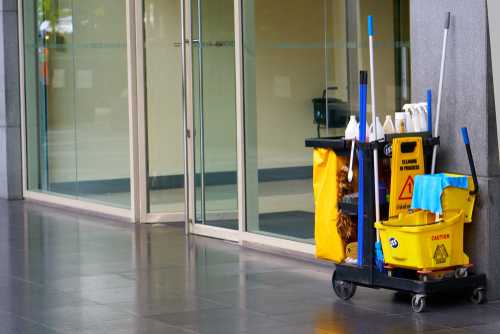We have learned a number of very valuable lessons from the pandemic that cannot be overlooked. This is true in many industry sectors but is especially true for facility managers, housekeeping departments, and contract cleaners hired to clean all types of commercial facilities.
Some suggest the critical lesson learned from the pandemic is just how essential disinfectants are in maintaining healthy facilities. Others, however, claim precisely the opposite.

The lesson learned, according to these critics, is that we overused disinfectants during the pandemic. In fact, according to Doug Gatlin, head of Green Seal, a leading green-certification organization, disinfectant use was up by more than 600% at the start of the pandemic.
This significant overuse can negatively impact the health of the cleaning worker, building users, and the environment. A term was even coined for this over-use: indiscriminate disinfecting.
Additionally, a recent study, published in the Journal of Allergy and Clinical Immunology, reached the same conclusion: The study reported that the increased use of disinfectant wipes and disinfecting liquids was significantly related to poorer asthma control. These findings are consistent with previous studies conducted primarily in occupational [work] settings that show increased exposure to disinfectants is related to increased asthma symptoms.
So, if it wasn’t the use of disinfectants that was the big “takeaway” from the pandemic, what is it? Some industry experts now conclude that it is the necessity for effective custodial training. For instance, Stephen Ashkin, long known as the “Father of Green Cleaning,” has recently written:
Cleaning does not happen by magic. COVID has taught [us] that custodial workers need training on the basics of cleaning, infection control, and prevention so workers know how to clean for health and protect themselves at the same time.
Many facility managers may not be aware of this, but professional custodial training has been an ongoing challenge in the cleaning industry for years. The reasons are many. Once cleaning workers are taught new cleaning methods and procedures, they often return to their old habits very soon after the instruction has ended.
Plus, at this time, the challenges of finding ways to train custodial workers effectively have been exasperated. Cleaning contractors are finding it very difficult to get workers, and when they do, these workers are often off to another job in just a few weeks or months. So, cleaning contractors are often reluctant to train new workers until they believe the worker may stick around for a while.
Some professional cleaning industry manufacturers have stepped up to the plate, attempting to address this situation. For instance, at least one manufacturer of “spray and vac” machines, better known as no-touch cleaning systems, has developed electronic “tutors.” Mounted on machines or downloaded as an app for a smartphone, these electronic tutors help instruct a worker how to perform a task and then allow the worker to practice what they have just learned.
“This play-and-practice technique has proven very effective at training cleaning workers,” says Mike Sawchuk, a Canadian cleaning consultant. “It also helps the [cleaning] worker feel more confident and self-reliant, which also facilitates effective cleaning.”
More Cleaning Lessons Learned
Facility managers should know additional takeaways from the pandemic, including the following:
Fair Pricing. As a former contract cleaner, I know all too well how much pricing affects who is hired to clean a facility. Years ago, invariably, the low bidder got the job. Some government entities required that the low bidder be selected. Facility managers must realize now that effective cleaning often means more frequent cleaning, the use of more helpful cleaning tools, and, as mentioned, better-trained cleaning workers. This can lead to higher costs, but facility managers should expect to pay a fair price if building users (and custodial workers) are to remain healthy in your facility.
Partners in Health. Not only are cleaning workers an expense, but they are also your partners when it comes to keeping facilities clean and healthy, more now than ever. View them as your frontline workers. “Working together,” according to Steve Ashkin (cited earlier), “COVID-19 has turned the expression cleaning for health into a reality.”
Keep Learning. While stagnant for years, the professional cleaning industry has been rapidly evolving over the past decade. Facility managers must stay up to speed with new developments and technologies. Usually, these new technologies are designed to improve cleaning effectiveness and help improve worker productivity, which can ultimately be a cost savings.
This last point is crucial. We must view cleaning that protects human health as part of a journey, one that is never-ending. And due to COVID, we must always be on the lookout for new ways to help prevent disease transmission.
Robert Kravitz is a frequent writer for the professional cleaning industry.
